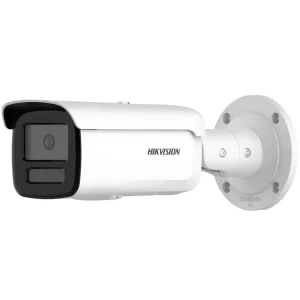DIY Hikvision CCTV Camera Installation
Are you looking to install a Hikvision CCTV camera system in your home or office but don’t want to spend a fortune on professional installation? DIY Hikvision CCTV camera installation can be a cost-effective and rewarding solution, but it can also be a daunting task. That’s why we’ve enlisted the help of a professional to share their tips and tricks for installing a Hikvision CCTV camera system. With years of experience in the field, our expert knows all the ins and outs of installation, from selecting the right equipment to positioning the cameras for optimal coverage.
In this article, we’ll cover everything you need to know to install your Hikvision CCTV camera system like a pro, including the tools you’ll need, the steps to follow, and the common mistakes to avoid. With our expert guidance, you can be sure your CCTV system will be up and running in no time, keeping your property safe and secure.
Benefits of Installing Your Own Hikvision CCTV Camera System
The benefits of installing your own Hikvision CCTV camera system are numerous. Firstly, you’ll save money on professional installation fees. By installing your own system, you’ll only have to pay for the equipment and avoid costly installation fees. Secondly, you’ll have complete control over the placement of your cameras, allowing you to customize your system to your specific needs. Thirdly, DIY installation provides a sense of satisfaction and accomplishment, knowing that you were able to set up a complex system on your own.
However, DIY installation may not be the best option for everyone. It requires time, effort, and a certain level of technical expertise. If you’re not comfortable working with electrical wiring or configuring network settings, it may be best to hire a professional.
Factors to Consider Before Installing Your Hikvision CCTV Camera System
Before you begin installing your DIY Hikvision CCTV camera system, there are several factors you should consider. Firstly, you need to determine the purpose of your system. Are you installing it for security purposes, to monitor your pets or children, or to keep an eye on your business? This will help you determine the number and placement of your cameras.
Secondly, you need to consider the environment in which your cameras will be placed. Will they be exposed to extreme temperatures or weather conditions? Will they be placed in high-traffic areas where they may be knocked around? These factors will help you select the appropriate cameras and mounting options.
Lastly, you need to consider the technical requirements of your system. Do you have the necessary equipment to run the cameras, such as a power supply and network cables? Do you have the technical knowledge to configure the cameras and network settings?
Tools and Equipment Needed for DIY Hikvision CCTV Camera Installation
Before you start a DIY Hikvision CCTV camera system, you’ll need to gather the necessary tools and equipment. Here’s a list of the essential items you’ll need:
- Power supply for cameras

- Network cables

- Monitor

- DVR/NVR

- Screwdrivers and screws
- Drill and drill bits
- Cable clips and ties
- Cable tester
It’s important to note that the specific tools and equipment you’ll need may vary depending on the size and complexity of your system.
Contact Us: +971 55 408 4213 or amjad@acssllc.ae.
Hikvision 4 MP Powered by Darkfighter Fixed Bullet Network Camera

- High-quality imaging with 4 MP resolution
- Excellent low-light performance with powered-by-DarkFighter technology
- Clear imaging against strong backlight due to 120 dB true WDR technology
- Efficient H.265+ compression technology
- Focus on human and vehicle target classification based on deep learning
- Water and dust-resistant (IP67)
Hikvision 2 MP AcuSense Motorized Varifocal Turret Network Camera

- High-quality imaging with 2 MP resolution
- Motorized varifocal lens for easy installation and monitoring
- Clear imaging against strong backlight due to 120 dB WDR technology
- Efficient H.265+ compression technology
- Water- and dust-resistant (IP67) and vandal-resistant (IK10)
- Focus on human and vehicle target classification based on deep learning
Hikvision 4 MP AcuSense Fixed Mini Bullet Network Camera

- High-quality imaging with 4 MP resolution
- Excellent low-light performance with powered-by-DarkFighter technology
- Clear imaging against strong backlight due to 120 dB true WDR technology
- Efficient H.265+ compression technology
- Focus on human and vehicle targets classification based on deep learning
- Built-in microphone for real-time auto-security (-U)
- Water and dust-resistant (IP67)
Step-by-Step Guide to Installing Your Hikvision CCTV Camera System
Now that you have all the necessary tools and equipment, it’s time to start installing your Hikvision CCTV camera system. Here’s a step-by-step guide to help you through the process:
1. Determine the location of your cameras. Use the factors you considered earlier to determine the best placement for your cameras.
2. Install the mounting brackets. Use a drill and drill bits to install the mounting brackets in the desired locations.
3. Install the cameras. Attach the cameras to the mounting brackets using screws.
4. Connect the cameras to the power supply. Use network cables to connect the cameras to the power supply.
5. Connect the cameras to the monitor or DVR/NVR. Use network cables to connect the cameras to the monitor or DVR/NVR.
6. Configure the network settings. Use the manufacturer’s instructions to configure the network settings for your cameras.
7. Test the system. Use a cable tester to ensure that all connections are working properly.
8. Clean up and organize the cables. Use cable clips and ties to organize the cables and ensure they’re out of the way.
Congratulations! You’ve successfully installed your Hikvision CCTV camera system.
Tips and Tricks for DIY Hikvision CCTV Camera Installation
Here are some additional tips and tricks to help you through the DIY Hikvision CCTV camera installation process:
1. Plan ahead. Before you start installing your system, take the time to plan out the placement of your cameras and the routing of your cables.
2. Use high-quality cables. Cheap cables can cause interference and poor image quality, so invest in high-quality cables.
3. Use a PoE switch. If you’re installing a large system, consider using a PoE switch to simplify the installation process.
4. Test your system regularly. Regular testing will help you identify and fix any issues before they become major problems.
5. Label your cables. Labeling your cables will make it easier to troubleshoot any issues that may arise in the future.
Common Mistakes to Avoid During DIY Hikvision CCTV Camera Installation
While DIY Hikvision CCTV camera installation can be a rewarding experience, there are some common mistakes that you should avoid:
1. Rushing through the installation process. Take your time and ensure that each step is done properly.
2. Overlooking the technical requirements. Make sure you have the necessary equipment and technical knowledge to install your system.
3. Poor placement of cameras. Make sure your cameras are placed in areas that provide optimal coverage and are not obstructed by anything.
4. Poor cable management. Poor cable management can lead to interference and poor image quality, so take the time to organize your cables properly.
Hikvision CCTV Camera Maintenance and Troubleshooting
Once your Hikvision CCTV camera system is installed, it’s important to perform regular maintenance and troubleshooting to ensure that it continues to function properly. Here are some tips for maintaining your system:
1. Keep your cameras clean. Dirty cameras can lead to poor image quality, so clean them regularly.
2. Check your cables. Check your cables regularly to ensure that they’re not damaged or loose.
3. Update your firmware. Check for firmware updates regularly and install them as needed to ensure that your system is up-to-date.
4. Test your system regularly. Regular testing will help you identify and fix any issues before they become major problems.
If you do experience any issues with your Hikvision CCTV camera system, here are some common troubleshooting steps:
1. Check your cables. Make sure all cables are properly connected and not damaged.
2. Check your power supply. Make sure your cameras are receiving power.
3. Check your network settings. Make sure your cameras are properly configured for your network.
4. Contact support. If you’re still experiencing issues, contact Hikvision support for assistance.
Frequently Asked Questions about Hikvision CCTV Camera Installation
Q: Do I need technical knowledge to install my Hikvision CCTV camera system?
Some technical knowledge is required, but if you follow the manufacturer’s instructions and take your time, you should be able to install the system on your own.
Q: How many cameras do I need for my system?
A: The number of cameras you need depends on the size of your property and your specific needs.
Q: Can I install my cameras outdoors?
A: Yes, but you’ll need to select cameras that are designed for outdoor use and take into consideration the weather conditions in your area.
Q: How often should I test my system?
A: You should test your system regularly, at least once a month, to ensure that it continues to function properly.
Conclusion: DIY Hikvision CCTV Camera Installation
Installing your own Hikvision CCTV camera system can be a cost-effective and rewarding solution, but it requires time, effort, and a certain level of technical expertise. By following the tips and tricks shared by our professional experts, you can ensure that your system is installed properly and functions as intended. Remember to take your time, plan ahead, and perform regular maintenance and testing to ensure that your system continues to keep your property safe and secure.
Alpha Capital Security Systems LLC provides support for the installation and maintenance of all security systems, including Hikvision, Dahua, Panasonic, Samsung, and Zkteco, in Dubai Sharjah Ajman. Contact Us: +971 55 408 4213 / amjad@acssllc.ae. Our Head Office is in Dubai, UAE
